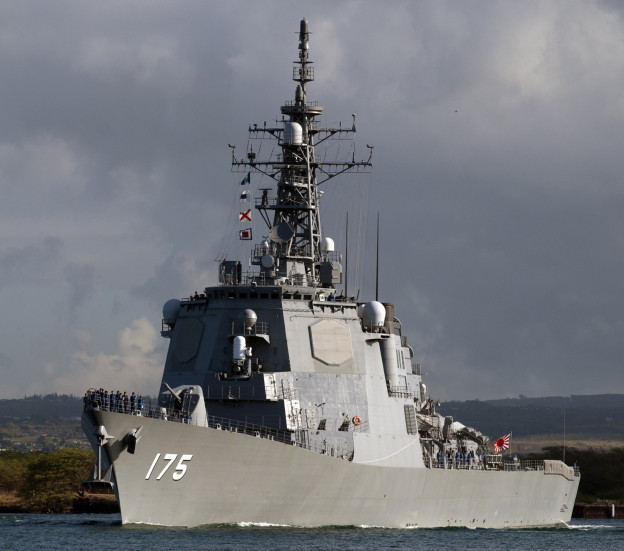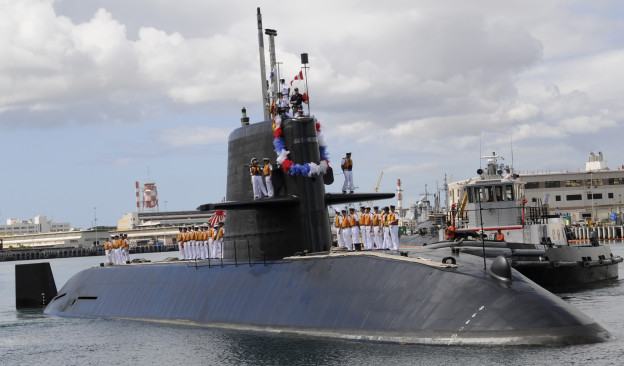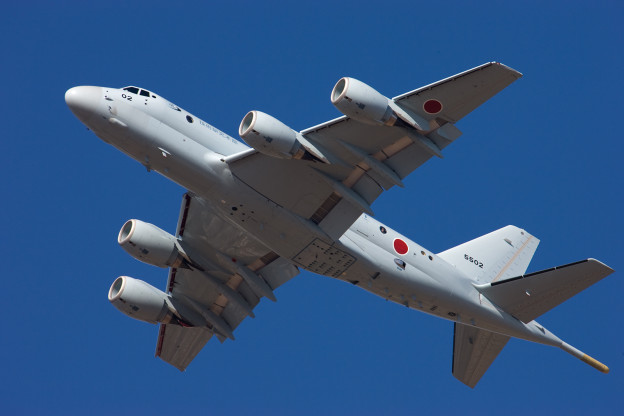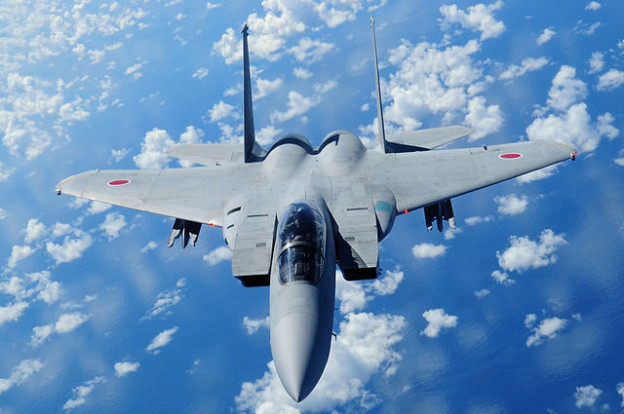
This week Japan approved its latest five-year defense plan. The Mid Term Defense Plan (MTDP) defines Japan’s defense policy and capabilities for 2014 to 2018. The MTDP is meant to give policymakers, politicians, and the public an understanding of Japan’s defense priorities and the direction national defense is taking.
The latest MTDP takes into account the new National Defense Program Guidelines, a policy document set to take effect in 2014. Citing the regional security environment as “more tense,” NDPG recommends strengthening Japan’s capabilities in the areas of intelligence-surveillance-reconnaissance (ISR), its ability to respond to attacks on Japan’s remote southern islands, ballistic-missile defense, cyber warfare, natural disasters, and the country’s joint operations capabilities.
The MTDP has been heavily influenced by recent friction with China. Since 2010 relations with the People’s Republic of China have fallen sharply, mainly over China’s claim of the Japanese-held Senkaku islands (Diaoyu islands in China.) Japan’s plan also addresses concerns regarding North Korea’s ballistic missile program.
The report emphasizes the U.S.–Japan security alliance as one of the cornerstones of its defense policy. In addition to that alliance, Japan also will seek friendly cooperation on regional defense issues with Russia, India, Australia, South Korea, and the ASEAN states.
More broadly, cooperation with the international community on issues of arms control, disarmament, and nonproliferation will mean a strengthening of ties with the European Union, NATO, OSCE, and other European countries. Japan also will continue to contribute to international peacekeeping missions, such as those in South Sudan and Golan Heights.
Despite the deteriorating relations, the plan emphasizes the importance of continuing to engage China both with security dialogues and exchanges.
Japan’s defense spending has remained relatively flat since 1992, and has declined slightly every year from 2002 to 2012. The defense budget is set to rise five percent over the next five years, to a total of $247 billion dollars. Coinciding with the spending will be a reorganization and redeployment of the Self Defense Forces that will shift units from across Japan to the southern periphery, including the Ryukyu islands and disputed Senkaku islands.

Japan’s navy—the Maritime Self Defense Force (MSDF)—will see a modest boost in ships. The number of diesel-electric submarines is set to rise from 16 to 22. Submarine construction is holding steady at one per year, and the rise will be accomplished, at least in the short term, by refurbishing submarines of the Oyashio class that would otherwise be retired. Japan’s submarines are typically retired after 18 years in service, so its older submarines are actually rather young compared with those of other countries.
The MSDF will also receive a boost in destroyers, with seven more to be acquired, including two Aegis destroyers. The new procurement plan will bring Japan’s total number of destroyers from 47 to 54, and Aegis destroyers from six to eight. In order to accommodate the extra destroyers within the MSDF’s force structure an additional escort flotilla will be formed. Each flotilla consists of two escort squadrons, with each squadron consisting of 4 destroyers. There are currently four escort flotillas, based at Yokosuka, Sasebo, Maizuru, and Kure.
Additionally, there reports that the MSDF is studying the purchase of littoral combat ships of its own. The Mainichi Daily News reports that small, high-speed escort ships to counter the threat of mines and submarines are being considered. Such ships would be ideal for operating in and around the Ryukyus, especially the Miyako Strait. The estimated cost per ship is $582 million.

Finally, four Kawasaki P-1 maritime patrol aircraft will be purchased, bringing the total number in service up to six. The P-1 is an indigenous design meant to replace the Lockheed P-3C Orion. It is similar to the P-8 Poseidon, the most notable difference being that it retains a magnetic anomaly detection boom. Up to 70 P-1s will ultimately be procured.
The Air Self Defense Force (ASDF) will see both a reorganization and injection of new aircraft. The number of ASDF intercepts of foreign aircraft has sharply increased, particularly over the Sea of Japan and the East China Sea. In response Japan is not only shifting aircraft southward, but is increasing the number of support aircraft and ground radar systems. Fighter aircraft will also see a modest boost.
The airborne early warning group, which oversees Japan’s four E-767 AWACS and 13 E-2C Hawkeyes, will purchase an additional four AWACS aircraft and increase the number of squadrons from two to three. One squadron will be based on Okinawa, where it will be able to monitor the Ryukyus and East China Sea. In addition to aerial radar platforms, the number of ground radar warning squadrons will be bumped to 28.

Japan is also sending fighters southward. Naha Airport will receive a second squadron of F-15J air superiority fighters, doubling the number of fighters based there from 20 to 40. Fighter squadrons will increase from 12 to 13, with the number of fighters set to grow from 260 to 280 units. Japan will acquire 28 F-35A Joint Strike Fighters during the five-year period covered by the Mid Term Defense Plan, with another 14 to follow later. Japan is considering a second F-35 purchase, possibly including the F-35B vertical takeoff and landing version for deployment on Japan’s Izumo and Hyuga-class helicopter destroyers.
Reflecting the National Defense Program Guidelines emphasis on intelligence collection, Japan plans on purchasing three Global Hawk unmanned aircraft. Provisions for study of acquiring Global Hawks are included in the 2014 budget, with the first units to be purchased in 2015.
Japan’s Ground Self Defense Forces (GSDF) will see the most change, with sweeping alterations to force structure. The new GSDF will feature three rapid-deployment divisions, three rapid-deployment brigades, one airborne brigade, one helicopter brigade, and one amphibious brigade.
The amphibious brigade will be built on the Western Army Infantry Regiment, a battalion-sized marine infantry unit based at Nagasaki on the southern island of Kyushu. The regiment has served for the past decade as Japan’s test bed for amphibious warfare, and has participated in the joint Iron Fist and Dawn Blitz exercises with United States forces.
The new amphibious brigade’s equipment heavily reflects that of the U.S. Marine Corps, which has taken a mentoring role over the Western Army Infantry Regiment. The brigade will incorporate 52 AAV-7 amphibious vehicles purchased from the United States, including command and recovery variants. The brigade will also incorporate the new Maneuver Combat Vehicle, a 26 ton 8×8 wheeled armored vehicle armed with a 105mm gun. The MCV is designed to be carried by the new C-2 transport for rapid deployment to Japan’s remote islands.
Like the U.S. Marines, the amphibious unit will also be airmobile, thanks to the purchase of 17 V-22 Osprey tilt-rotor aircraft. The first Osprey will be procured in April 2014 and the procurement process is expected to last five years.
Although the main body of the amphibious brigade will likely remain based at Nagasaki, there are reports a smaller training unit will be established on the northern island of Hokkaido, at Camp Higashi Chitose.
The Mid Term Defense Plan and National Defense Program Guidelines represent a significant change in Japanese defense policy. New capabilities, such as ISR assets, joint operations, and amphibious units will go a long way toward addressing gaps in Japan’s existing defenses. The reorganization of the Self Defense Forces, as well as procurement initiatives for equipment such as the Osprey and Global Hawk will create a foundational basis for the defense of Japan’s southern islands.





